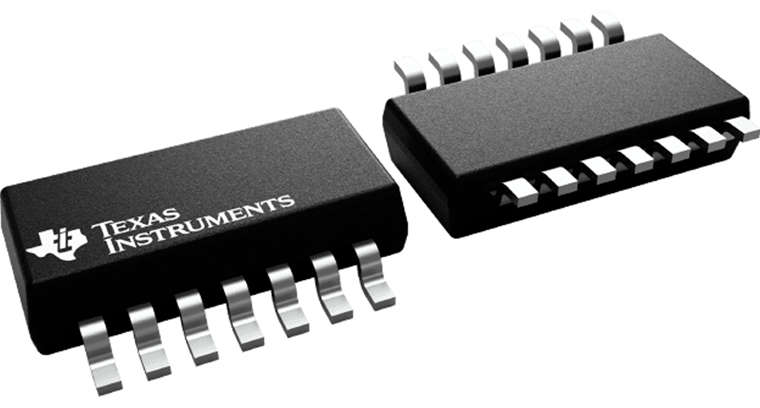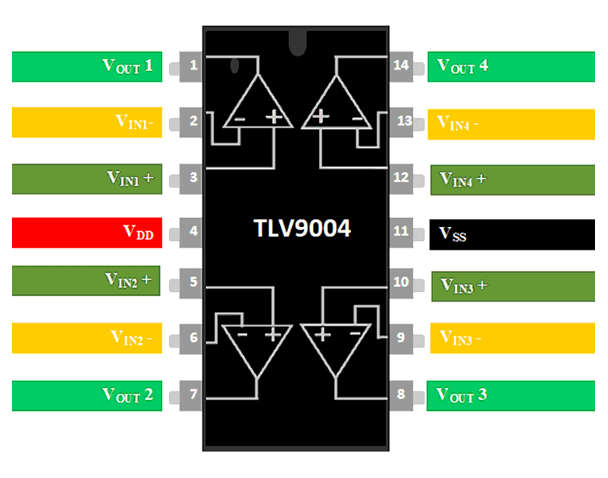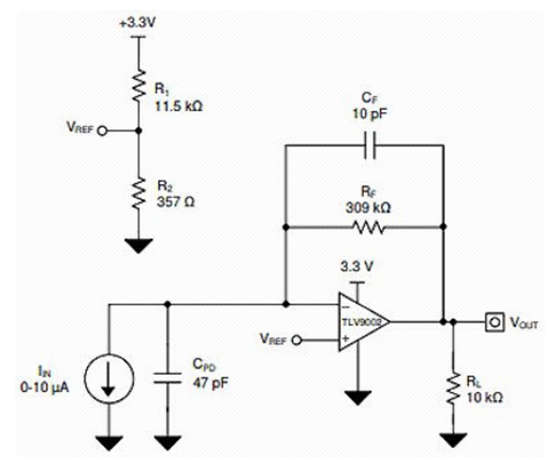- The TLV900x operational amplifiers are offered with special features such as unit gain stabilization, built-in EMI and RFI rejection filters, and phase less reversal in overclocked conditions. These are primarily designed to simplify the circuit. The TLV900X series of operational amplifiers include the TLV9001 (single-channel op-amp), TLV9002 (two-channel op-amp), and TLV9004 (four-channel low-voltage op-amp).

- The TLV9004 is a quad-channel low-voltage (1.8 V to 5.5 V) operational amplifier with rail-to-rail input and output swing capabilities. It is targeted to be used in space-constrained applications such as smoke detectors, wearable electronics, and small appliances where low-voltage operation and high capacitive-load drive are required.
What is TLV9004 Op-Amp?
- The TLV9004 op-amp is a low voltage operational amplifier, which comes within the TLV900x op-amps family designed by Texas Instruments. Generally, they are specifically designed for low power, rail-to-rail output, and input capabilities for portable electronic applications. Class AB output stage can drive a load less than or equal to 10 k Ohm loads, which are connected at any point between positive voltage (V+) and negative voltage (V-).
- The common mode input voltage range includes the input and output rails allowing the TLV900x op-amp to be used in any type of single supply application. The TLV9004 op-amp is a four-channel low-voltage operational amplifier with rail-to-rail inputs and output swing capabilities.
It is primarily used in space-oriented applications such as wearable electronics, smoke detectors, and small electronic devices where high capacitance load drive and low voltage operation are essential. The operating voltage range is between 1.8V and 5.5V.
Pin Configuration/Pin Diagram
- The TLV9004 Op-amp is a 14-pin operational amplifier available in a 16-pin PW package, an RUC package, and an RTE package in WQFN. It has four positive output voltage pins, four negative output voltage pins, one supply pin, and one ground pin.

- Pins 1,7,8,14 – (output voltage pins for four operational amplifiers): OUT1 is the output voltage for channel 1, OUT2 is the output voltage for channel 2, OUT3 is the output voltage for channel 3 and, OUT4 is the output voltage for channel 4.
- Pins 2,6,9,13 – (reversing the input voltage pins of four operational amplifiers): IN1- Reverses the input voltage of channel 1, IN2- Reverses the input of channel 2, IN3- Reverses the input voltage of channel 3, and IN4- Reverses the input voltage For channel 4 amps.
- Pins 3,5,10,12 – (non-inverting input voltage pins for four operational amplifiers): IN1 + is the non-inverting input voltage for channel 1, IN2 + is the non-inverting input voltage for channel 2, IN3 + is the non-inverting input voltage for channel 3, and IN4+ is the non-inverting input voltage of channel 4 op-amp.
- Pin4 (VDD (V+)): Positive rail or voltage source (high).
- Pin11 (Vss (V-)): negative rail or ground pin (low voltage source).
TLV9004 Operational Amplifiers Features and Specifications
- The TLV9004 Op-Amp specifications or technical features are described below.
- The operating voltage range of the TLV9004 op-amp is between 1.8V and 5.5V.
- Low input compensation voltage at ±0.4V.
- The input bias current is low, i.e. 5 Pa.
- Quiet current is low, i.e. 60 mA/sec.
- Gives gain unit bandwidth: 1MHz.
- The broadband noise is low, which can be 27 NV/Hz.
- Extended operating temperature range is -40°C to +125°C.
How to use the TLV9004 Op-Amp/Circuit Diagram
- To understand how to use the TLV9004 op-amp, a simple single-width optical amplifier circuit is considered. The circuit diagram of a single supply optical amplifier using the TLV9002 op-amp is shown below.

- To convert light energy (signals) into electrical energy (signals), photodiodes are utilized. The photon energy absorbed is proportional to the current through the photodiode, which is in the range of a few hundred picofarads to a few tens of microamps. To convert the photodiode current of low-level to a voltage signal that is used for processing in an MCU, the amplifier circuit is designed in a trans-impedance configuration.
The components required to design a single-supply photodiode amplifier circuit are given below.
- 3.3 Volts supply voltage
- 0 microamps to 10 microamps input
- 0.1 Volts to 3.2 Volts output
- 50 kHz bandwidth
- TLV9002 op-amp
- 11.5 Kilohms, 309 kiloohms, 357 ohms 10-kilo ohms resistors
- 47 pF, 10 pF capacitors
The equation between the input current (Iin), output voltage (Vout), and the reference voltage (Vref) gives the transfer function as shown below
Vout = In x Rf x Vref
Where Vref = V+ (R1R2/R1+R2)
Rf = feedback resistance
To obtain the minimum output voltage, Vref is set to 100 mA by adjusting the R1 and R2 resistor values. Then the ratio is calculated as,
Vref/V+ = 0.1 V / 3.3 V = 0.0303 V
To meet this ratio, set the resistors to R1 to 11.5-kilo-ohms and R2 to 357 ohms.
Based on the input current and the desired output voltage, the required feedback resistance is calculated as below.
Rf = (Vout – Vref)/Iin = (3.2 – 0.1) / 10 microamps = 310 kV/Amps = 308-kilo ohm
Based on the feedback resistance Rf and the bandwidth -3dB, the required value of the feedback capacitor is calculated as shown below,
Cf = 1/(2π x Rf x F at -3dB)
= 1/(2π×309x 50) = 10.3 pF = 10 pF
The minimum bandwidth required by the op-amp for this circuit application depends on the Cf, Rf, and the capacitance on the input pin of the TLV9002 op-amp. The sum of shunt capacitance of the photodiode (Cpd), the common-mode input capacitance (Ccm), and the differential input capacitance (Cd) gives the value of shunt input capacitance of input capacitance (Cin) of the TLV9002, which is given below,
Cin = Cpd + Ccm + Cd = 47 pF + 5 pF + 53pF = 53 pF
The formula used to calculate the minimum bandwidth of the op-amp is given below,
F >= (Cin + Cf) / (2π x Rf x Cf^2) >= 324KHz
Hence we can conclude that the bandwidth of 1MHz of the TLV900x is used to meet the required minimum bandwidth and remains stable in this configuration. To reduce the coupling errors from the high impedance power supply and the noise signals, the bypass capacitor of 0.1 pF is connected near the power supply pins.
Applications of TLV9004 Op-Amp
- power units
- sensor signal conditioning
- Motion and smoke detectors
- Small and large appliances
- wearable devices
- barcode scanners
- personal electronic systems
- HVAC Systems (Heating, Ventilation and Air Conditioning Systems)
- motor control systems
- Active Filters
- Low Side Current Sensing Circuits
